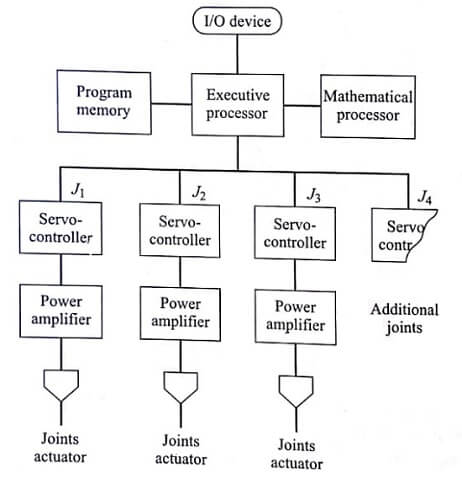We can develop a general configuration for a robot controller. The elements needed in the controller include: joint servo controllers, joint power amplifiers, mathematical processor, executive processor, program memory, and input device. The number of joint servo controllers and joint power amplifiers would correspond to the number of joints in the manipulator. These elements might be organized in the robot controller as shown in fig.

Motion commands are executed by the controller from two possible sources: operator input or program memory. Either an operator inputs commands to the system using an input device such as a teach pendant or a CRT terminal, or the commands are downloaded to the system from program memory under control of the executive processor.
In the second case, the set of commands have been previously programmed into memory using the operator input device(s). For each motion command, the executive processor informs the mathematical processor of the coordinate transformation calculations that must be made.
When the transformation computations are completed, the executive processor downloads the results to the joint controllers as position commands. Each joint controller then drives its corresponding joint actuator by means’ of the power amplifier.
Microprocessors are typically utilized in several of the components of a modern robot controller. These components include the mathematical processor, the executive processor, the servo controllers, and the input device.
Each of the control boards makes use of a common data buss and address buss. The microprocessors communicate with each other by sending messages into common areas in the system memory.
This architecture provides several advantages in the design of the controller. These advantages include commonality of components, expansion of the system to more joints, and information flow between joint control elements.
For example, the control configuration would permit the sharing of feedback information among the various joints, thus providing the opportunity to develop algorithms for improving the individual joint dynamics.
Microprocessors are typically utilized in several of the components of a modern robot controller. These components include the mathematical processor, the executive processor, the servo controllers, and the input device. Each of the control boards makes use of a common data buss and address buss.
The microprocessors communicate with each other by sending messages into common areas in the system memory. This architecture provides several advantages in the design of the controller.
These advantages include commonality of components, expansion of the system to more joints, and information flow between joint control elements.
For example, the control configuration would permit the sharing of feedback information among the various joints, thus providing the opportunity to develop algorithms for improving the individual joint dynamics.
| Read More Topics |
| Robot applications |
| Robot programming |
| Robot drive system |
| Common robot configuration |





